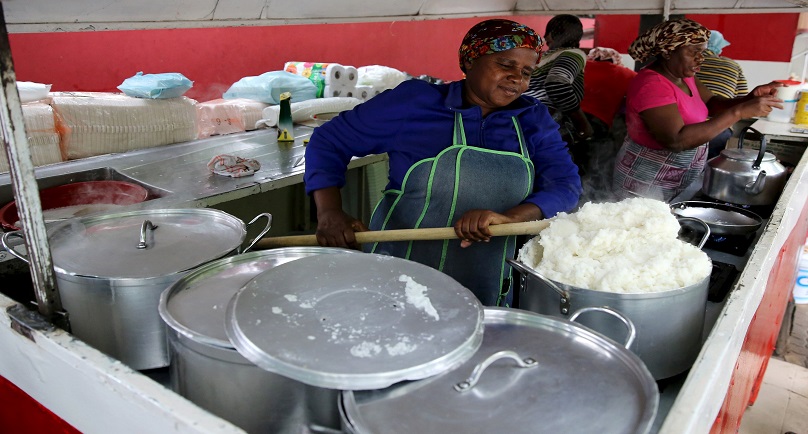Image: Lindi Sehlabela prepares “pap”, a traditional porridge made from mielie-meal (ground maize), for her customers in her makeshift shop in Sandton January 20, 2016. REUTERS/Siphiwe Sibeko
By Ed Stoddard
JOHANNESBURG (Reuters) – South Africa’s rainbow nation faces a drought-induced corn conundrum about the color of its staple, a starchy cake-like mixture derived from maize: white, yellow or a mix of the two?
In South Africa, white maize is made into what is known locally known as “pap”, the main source of calories for many households. The yellow variety is used almost exclusively as animal feed.
But a shortage of white maize looms after South Africa experienced its driest year on record in 2015. Prices for both have soared to record highs but yellow maize remains cheaper and can be imported from a variety of countries, unlike the white.
People in the outside world, many of whom happily eat yellow maize, may wonder what the fuss is all about – Italians consider their yellow maize version, polenta, a bit of a delicacy. But South Africans have a cultural aversion to eating a food they consider fit only for livestock, for all its nutritional merits.
“I would eat something else. I won’t eat yellow pap,” said 58-year-old taxi driver Elliot Ngindi as he stood by a street vendor in Johannesburg’s financial district of Sandton, where several women cooked huge pots of pap.
Customers waiting in line nodded in agreement, expressing the kind of horror that French wine drinkers might show when told to give up their favorite vintage for a discount bottle from the supermarket.
“In South Africa, we have real ‘pap connoisseurs’ and they may not like the mix,” said Chris Schoonwinkel, a commercial maize farmer from South Africa’s grain belt, which stretches east and west of Johannesburg.
Outside southern Africa, white maize is grown in significant quantities only in Mexico and the United States. With the domestic price doubling in 2015, large-scale imports may be unaffordable.
Farmers, millers, producers and retailers all have a stake in how consumers respond, with food prices expectedto surge as crops wither during the worst drought in three decades.
“They are going to have to switch from white to yellow,” said Piet Faure, a maize trader at CJS Securities, adding that white maize would be too costly for most consumers.
The March contract for white maize closed over 2 percent higher on Wednesday at a new peak of 5,296 rand ($315) a ton. Yellow maize has also hit records this week and the March contract is just shy of 4,000 rand a ton.
CHOKING DOWN A MIX
Yellow maize was used in pap during a severe shortage in the early 1990s. So sensitive is the issue that the government needs to give its approval for millers to mix white with yellow in Africa’s biggest grain producer.
The government hopes imports will get into full swing within the next few months, but has signaled it will probably allow the mix to be sold. “We have had yellow pap before. Our position is that we may have both white and yellow maize from May of this year,” Agriculture Minister Senzeni Zokwana told Reuters.
Consumers will probably have to hold their noses and choke down yellow pap or a mix of the two. South Africa may have to import up to 6 million tonnes of maize this year, over half its requirements.
Industry sources say food prices may rise 20 percent or more this year, putting significant upward pressure on overall inflation, which accelerated to 5.2 percent in December from 4.8 percent in November.
The central bank, which is expected to raise interest rates next week, has cited the drought and food inflation as major concerns.
So price considerations are paramount as food producers and retailers try to protect their profit margins while keeping the staple that feeds South Africa affordable.
“Mexican white maize will be at a substantial premium and there is no certainty with regard to pricing and quality … We will consider all options to ensure affordability for our consumers,” said a spokesperson for producer Tiger Foods.
A spokesperson for Pioneer Foods said the producer was looking at the option of blending the two varieties of maize but noted that “white maize meal is preferred by consumers even though yellow maize meal is nutritionally similar”.
(Additional reporting by TJ Strydom; Editing by James Macharia and David Stamp)
Copyright 2015 Thomson Reuters. Click for Restrictions.


